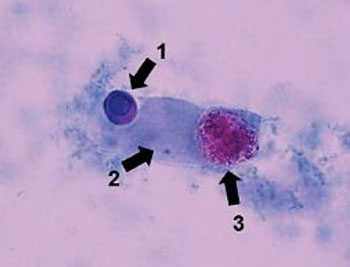Urinary Round Cells Predict Need For Hemodialysis
By LabMedica International staff writers
Posted on 28 Jun 2016
Urinalysis is a safe, easy, and cost-effective diagnostic tool, and sediments are indicative of nephron condition, therefore, it can be considered as a virtual renal biopsy and is useful for the differential diagnosis of acute kidney injury and chronic kidney disease.Posted on 28 Jun 2016
Voided urine contains a variety of cells from the kidney and urinary tract and urinalysis provides diverse information when the cellular components are investigated. However, not all cells in the urine have been characterized and the origins of cells have not been determined in some cases.

Image: A photomicrograph of (#1) a round cell in urine sediment Sternheimer stain; (#2) a hyaline cast; (#3) and a macrophage (Photo courtesy of the University of Tokyo).
Scientists at the School of Medicine, The University of Tokyo (Japan) and their colleagues collected spot urine samples from 372 patients, 278 males and 94 females. Male patients were 68.4 years on average, range 30 to 95 years and females were 67.9 years on average, range 26 to 89. A total of 247 cases had diabetes and 125 did not have diabetes were included in the study.
Urine sediments were prepared and examined following a previously defined method. Round cells were counted at 100 × magnification in whole-field (WF) view and scored as negative, 1–4/WF, 5–9/WF, or greater than 10/WF. Serum creatinine estimated at two years and six months before the examination, on the day of examination and six months after the examination were compared with the round cells scores. Urine sediment was prepared for immunohistochemistry using Smear Gell (GenoStaff, Tokyo, Japan) processed and immunofluorescence staining was observed under a fluorescence microscope, BZ-X700 (Keyence, Osaka, Japan). Ribonucleic acid (RNA) extraction and quantitative real-time reverse transcription-polymerase chain reaction were performed on sediment cells, which were also cultured.
The scientists found ‘round cell’ to be distinct from known cells in sediment and is close to proximal convoluted tubule-derived cells based on morphology and molecular marker expression Gamma-Glutamyltransferase 1 (GGT1) but not podocalyxin. Also it was positive for undifferentiated cell markers, including Paired box gene 2 (PAX2), Wilms Tumor 1 (WT1), Odd-Skipped Related Transcription Factor 1(OSR1), and SIX Homeobox 2 (SIX2). They were observed in end-stage renal failure patients and the number of cells was correlated with the severity of chronic kidney disease. A prospective analysis revealed that patients who had more round cells were more likely to require hemodialysis within a year.
The authors concluded that the novel round cell is close to tubular epithelial cells and expresses undifferentiated cell markers. Round cells can be substantially detected in advanced renal failure and could be a novel marker for kidney death within a year for both in diabetic and non-diabetic kidney disease. The study was published on June 1, 2016, in the journal Clinica Chimica Acta.
Related Links:
School of Medicine, The University of Tokyo
GenoStaff
Keyence




 assay.jpg)









